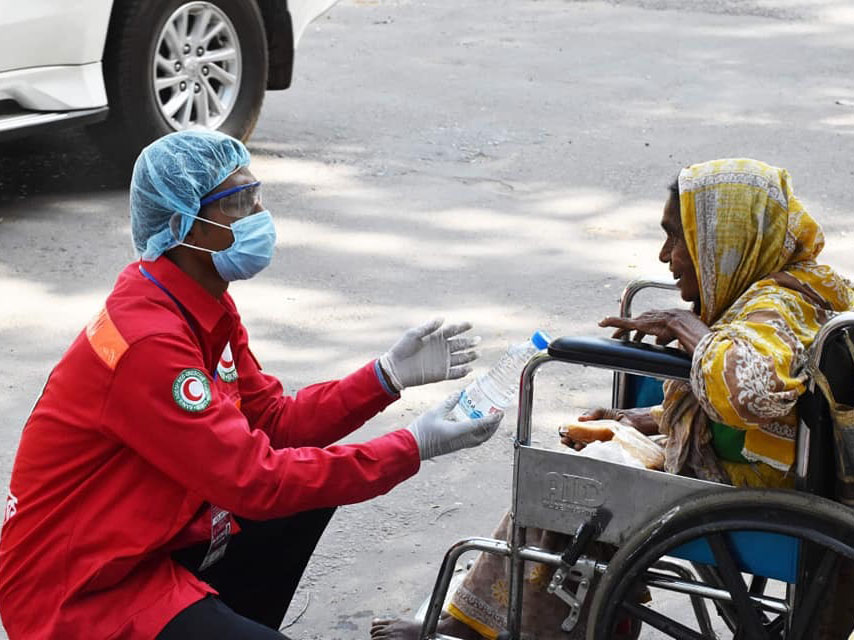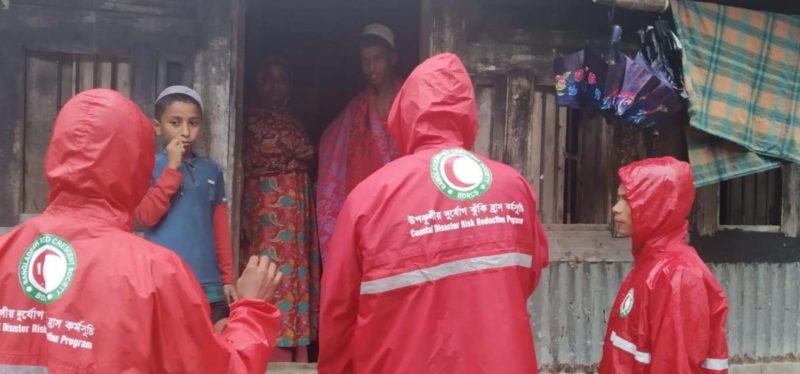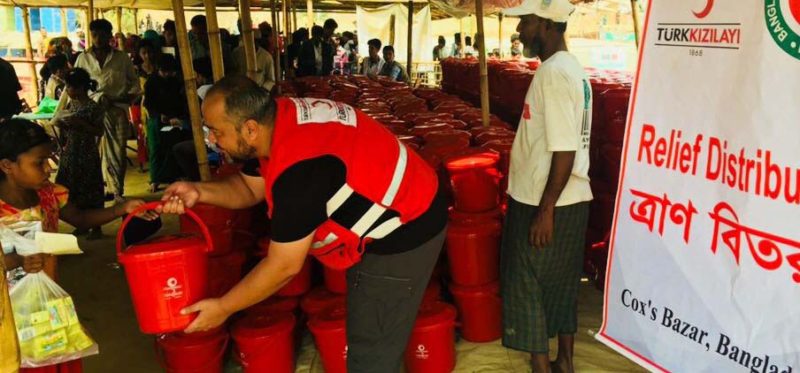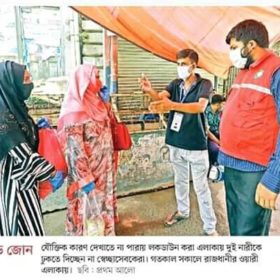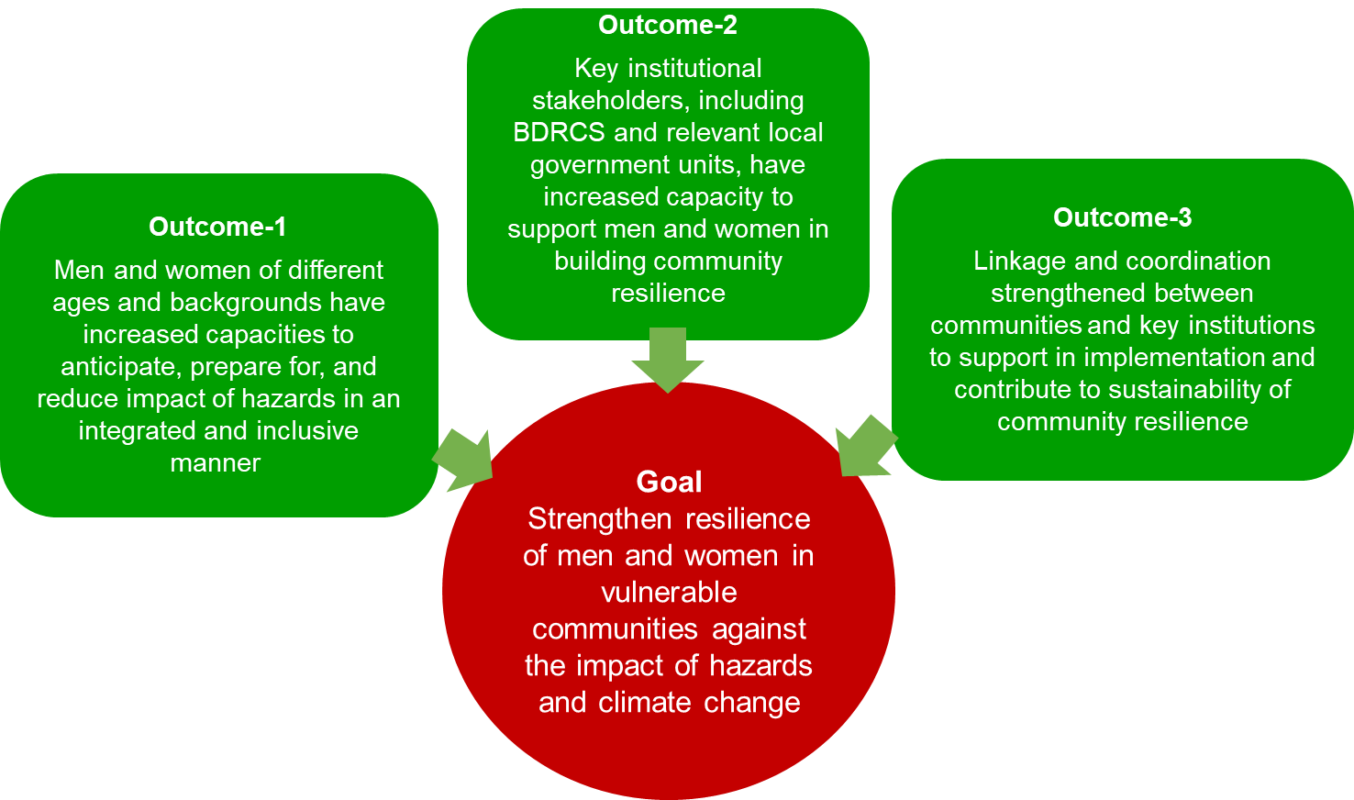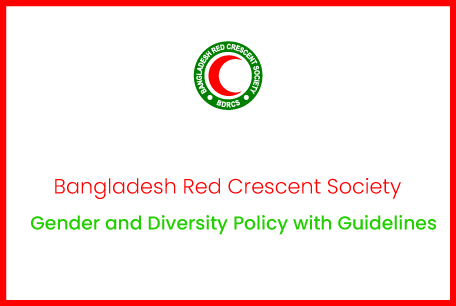Integrated Resilience Program (IRP):
This project aims to support men and women of different ages and backgrounds in the communities in enhancing their resilience against the impact of hazards through an integrated and inclusive resilience approach. This comes from the recognition and key learnings from other RCRC resilience projects that attaining resilience necessitates people-centeredness but at the same time have a holistic take with the involvement of different levels of society.
1. KEY PROJECT INFORMATION
|
Implementing partner (IFRC/ National Society/ies): |
Geographical coverage: |
Type of intervention (sector/area): |
|
BDRCS |
Jamalpur District |
Multi-sector (DRR, Health and WASH, Livelihoods, NSD) |
|
Expected start date: |
Expected duration: |
Number of people to be reached: |
|
01-01-2018 |
3 years |
8,200 people
|
|
The Project Funded by: |
||
|
SRC (Swedish Red Cross) |
||
|
Key outcomes of the project (goal and outcomes): |
||
|
Goal: Strengthen resilience of women and men in vulnerable communities against the impact of hazards and climate change Key Outcomes:
|
||
2. PROJECT SUMMARY
This project aims to support men and women of different ages and backgrounds in the communities in enhancing their resilience against the impact of hazards through an integrated and inclusive resilience approach. This comes from the recognition and key learnings from other RCRC resilience projects that attaining resilience necessitates people-centeredness but at the same time have a holistic take with the involvement of different levels of society.
The project aims to adopt an integrated and inclusive approach where ‘integrated’ refers to the effective integration among and within basic sectors where highest vulnerabilities are identified such as livelihoods, health and WASH, and how these relates to overall reduction of disaster risks as well as the ability to withstand, prepare, and cope against the impact of hazards.
This project, having an integrated approach, also refers to acknowledging that resilience can only be attained through concerted efforts. This means that the project design should not solely focus on community groups and structures, but also support and connect local institutions such as the DMCs from district, upazila, union and ward levels, the BDRCS branch, and other key institutional stakeholders (NGOs, private organizations, academic institutes). These institutions which will be able to augment support and facilitate sustainability of resilience initiatives.
The project will maintain a certain degree of flexibility in defining activities as it will use the results of the participatory VCA and sector-specific assessments to define the priorities of each community. Specific activities and targets will be updated and validated after the assessments are conducted.
Considering that the scoping study emphasized how women are one of the most vulnerable particularly during disasters and taking into account lessons from ongoing Resilience Programs as well as the momentum built on the BDRCS Gender and Diversity Project, this project adopts a stronger focus on gender and diversity as a condition for community resilience. This will be incorporated through a better understanding and mainstreaming of an ‘inclusive’ approach – defined as “acknowledging diversity in society, upholding equality of rights and opportunities, ensuring dignity of individual or group, and not excluding community members due to age, gender, disability or other characteristics.”
Project activities will be designed in a manner where women of all ages and backgrounds can take on a more proactive role in resilience work with the aim of:
-
Challenging mindsets, norms and traditions that restrict women’s rights, security, roles, and influence in disasters;
-
Contributing to increased action at local level to act before, during and after a disaster. By forming ‘Women’s Squads’ within the micro-groups, CDMCs and CDRTs, a women’s choir in the district, conditions are created to give women equal opportunities to take a leading role in how disasters are managed, thus utilizing how women want to address problems that a disaster entails; and,
-
Helping more women reach other women with life-saving help and be more involved in resilience work.
3. BACKGROUND
3.1 OVERVIEW OF BDRCS
Bangladesh Red Crescent Society (BDRCS) is one of the largest humanitarian organizations working in Bangladesh constituted in 31 March 1973. It has a country-wide presence with 68 branches located across all 64 districts and four (4) metropolitan cities of the country. BDRCS has more than 780,000 Red Crescent Youth (RCY) members, 55,260 Cyclone Preparedness Programme (CPP) volunteers, a pool of 80,165 life members, and 492 experienced officers and staff working at the national headquarters and branches.
As an auxiliary to the Government of Bangladesh (GoB), BDRCS works towards providing humanitarian assistance and increasing community resilience of the most vulnerable. While earlier, its focus was on post-disaster relief and response, later BDRCS incorporated Community-based DRR (CBDRR) approach into their projects. The idea of moving from Disaster Management (DM) to DRR was conceived in BDRCS after the 1970’s cyclone that killed over 500,000 people in Bangladesh. Its operation started with the formation of CPP with 20,000 volunteers in 1973.
Considering changing nature of disasters and climate, BDRCS has adopted a multi-hazard and holistic approach. In line with the BCCSAP and Standing Order on Disasters (SoD), the IFRC Strategy 2020, and the Sendai Framework for Action, BDRCS has been implementing projects focusing enhancing community resilience. In addition, Bangladesh is among the selected countries where the IFRC Framework for Community Resilience (FCR) Roadmap to Resilience (R2R) tool is being piloted starting 2017.
Over the last 41 years, BDRCS has undertaken a wide range of activities in DRR, Health, Capacity building, and in promoting Red Cross Red Crescent (RCRC) ideals and principles. In spite of various challenges faced, BDRCS continues to make steady progress towards realizing its vision and achieving its mission of providing vital services to the most vulnerable in an effective, transparent and self-sustainable manner.
In terms of BDRCS’ capacity on Gender and Diversity, a baseline study was conducted by IFRC with the support of Swedish Red Cross (SRC) last 2015. The study found a sound understanding of the term ‘Gender Equality’ among staff and volunteers, whereas ‘Gender Mainstreaming’ seems to be a new concept. BDRCS has shown commitment towards prioritizing Gender and Diversity through the formulation of a Gender Policy in 2005 and the establishment of a Gender Working Committee (GWC) in 2012. However, the study also found limited knowledge on related policies and the roles and responsibilities of the GWC in terms of mainstreaming gender and diversity in the organization and in its emergency response operations and long-term programs.
3.2 OVERVIEW OF BDRCS-SRC PARTNERSHIP
Swedish Red Cross (SRC) has been a long-standing partner of BDRCS in addressing humanitarian needs of vulnerable communities in Bangladesh. SRC is known for its support in the establishment of CPP. With in-country presence established in 2014 to date, SRC continues to be one of the main Partner National Societies (PNS) supporting long-term resilience projects, National Society Development (NSD) projects on Gender and Diversity and Planning, Monitoring, Evaluation and Reporting (PMER), and emergency response operations.
During the Partnership Review Talks (PRT) in November 2014, BDRCS and SRC senior management agreed to explore options of a new Resilience Project through a bilateral mode of partnership. This takes into consideration both development and humanitarian needs in Bangladesh and lessons learnt from previous and ongoing Resilience Projects, as well as its alignment to the BDRCS Strategic Plan 2017 – 2020 and Humanitarian Strategy of the SRC 2016-2019. Hence, this project proposal for the new BDRCS-SRC Integrated Resilience Project (IRP) is developed through a scoping process undertaken in 2017.
SRC supported several programs on enhancing community resilience in Bangladesh. IRP takes into consideration the lessons learned from the implementation of these programs 3, which mainly includes:
-
Including local government institutions in the resilience equation not just a stakeholder to be consulted from time to time but to be actively engaged and involved in implementation of activities. While previous and ongoing programs (e.g. CBDRR and V2R) included local government stakeholders in activities, these were done on a needs-basis and limited to providing technical support (e.g. Agricultural Extension Office for livelihood activities).
-
Strengthening the linkage of community-based groups with existing government Disaster Management Committees in terms of risk assessment, risk reduction and resilience action planning, advocacy, and implementation. This is one of the strategies of IRP to facilitate sustainability of outputs beyond the life of the project.
-
Improving approach from product-based to process-based. Previous and ongoing programs (e.g. CBDRR and V2R) had been designed to provide solutions already pre-defined in the project proposal and logical framework. This entailed less degree of flexibility to address needs based on the results of the participatory Vulnerability and Capacity Assessment (VCA). This also led to communities receiving the same type of intervention (e.g. similar quantities of latrines, same length of drainage canals) even if the needs are different.
-
Strengthening Gender and Diversity and the inclusion approach in activities. This is further defined in the following sections of this proposal.
-
Strengthening the Health component of the project linking it with BDRCS Maternal and Child Health Center (MCH) as previous programs did not fully incorporate Health in their respective design due to various reasons.
Through the implementation of the SRC-supported Gender and Diversity Project in 2017, a series of trainings and orientations were conducted to increase awareness and understanding on concepts, policy frameworks, and the IFRC Minimum Standard Commitments on Gender and Diversity for the BDRCS staff and volunteers in the National headquarters and selected district branches. It is also expected that by the end of March 2018, a Child Protection Policy is finalized and a draft updated Gender Policy will be completed.
In order to continue the momentum and sustain the SRC-supported initiatives on Gender and Diversity and PMER, the IRP aims to roll-out activities of both focus areas in the selected district as it relates to programming and NSD. In addition to this and outside of the scope of IRP, SRC will continue to support, provide technical guidance, and advocate for the effective mainstreaming of Gender and Diversity in BDRCS emergency response operations, and the Resilience Programs supported by IFRC and PNSs (e.g. Vulnerability to Resilience Barisal by the British Red Cross, NSD Project of the German Red Cross).
4. CONTEXT ANALYSIS
The needs for this project have been assessed through a scoping study led by a team from BDRCS and SRC (See Annex 1. BDRCS-SRC Scoping Study Report, November 2017). The study is divided into phases where Phase 0 (May) involved an internal assessment of BDRCS capacity in finance, logistics, and human resource (HR); Phase 1 (June-Sept) involved collection of qualitative and quantitative analysis of hazard, vulnerability and capacity indicators from secondary data sources for all 64 districts of Bangladesh to rank them according to vulnerabilities rate; Phase 2 (Sept-Oct) involved the detailed assessment of sample districts with the highest vulnerability ranking from Phase 1, and represent the major hazards and regions in the country; and the Phase 3 (Oct-Dec) focusing on developing this project proposal.
Country Level
Bangladesh, officially known as the People’s Republic of Bangladesh, is one of the most densely populated countries in the world with a population of approximately 162 million people and nearly 30% living in poverty. Due to is geographic location in South Asia, the country is highly vulnerable to man-made and natural disasters such as fires, structure collapse, cyclones, floods and earthquakes, as well as climate change. Bangladesh is ranked fifth in the disaster risk among the world. 4 The most vulnerable population being women, small marginal farmers, sharecroppers, laborers, urban slum dwellers, indigenous and minority groups, and other marginalized groups, such as the Persons with Disabilities (PWD).
The country is prone to flooding due to its location on the Ganges Delta and the many tributaries flowing into the Bay of Bengal. The strong monsoon rains, coupled Bangladesh’s location in the delta of the world’s second largest river basin, makes it extremely vulnerable to recurring floods. Furthermore, 75% of Bangladesh is less than 10 meters above sea level and 80% of its land areas are considered flood plains.
Over the last 30 years, Bangladesh has experienced nearly 200 hydro-meteorological related disasters, of which have killed thousands of people, destroyed homes and livelihoods and cost the nation around $16 billion in damage and economic losses. Given Bangladesh’s natural geography of rivers and tributaries, floods affect Bangladeshis more than any other disaster. Around 30-50% of the country experience floods annually. Major floods in 2017 have affected more than 7.4 million people in over 50% of the country’s 64 districts.
Because of these, the Government of Bangladesh (GoB) has made progress in Disaster Preparedness through plans and policies. The country is gradually shifting its DM approach to a comprehensive DRR approach based on experiences, lessons learned, and the aim to reduce future adverse impacts. Disaster Management Committees (DMCs) have been established at different administrative levels. As a result, Bangladesh exceeded the regional averages for the Asia-Pacific in the Hyogo Framework for Action (HFA) Progress Report (2013) and scored a higher than the average score in every category including early warning systems, risk assessment, DRR policy, and preparedness for effective response. Bangladesh earned these scores by tirelessly implementing various national plans supporting DRR and Climate Change Adaptation (CCA).
In terms of gender-related issues, Bangladesh is a highly patriarchal society as gender is a main factor in defining social roles, responsibilities, and power relationships in the family and workplace. The country ranks relatively low on the 2010 Gender Inequality Index 5. In 2014, 43.1% females and 80.9% males were recorded as working for cash income. 6 More than three-quarters of the female labour force works in agriculture. However, women do not experience similar working conditions, wages and benefits as men. They are disproportionately affected by un-/under-employment and vulnerable employment. This and stereotype gender roles related to low literacy, limited mobility, restricted access to public sphere and role as caregivers, make women more vulnerable in disasters. In 1991 Cyclone Sidr, the death rate was 71 per 1000 women aged 20-44 compared to 15 per 1000 men 7. Moreover, sexual- and gender based violence (SGBV) is a serious issue, including sexual, domestic, and dowry-related violence, early marriages, acid attacks, kidnapping and trafficking. In the 2011 Violence Against Women Survey, 65% of married women experienced physical violence committed by their husband. During 2015 BDRCS and IFRC conducted a SGBV case study as part of the global study Unseen, Unheard: Gender- based violence in disasters. The study conclude that SGBV tend to increase during natural disasters, not at least when people are displaced. Key findings from the Bangladesh case study were:
-
Low awareness of rights in relation to GBV amongst affected population;
-
Lack of available data on prevalence and patterns of GBV;
-
Variation across different administrative levels regarding availability and access to GBV response services;
-
Variation of level of awareness among internal staff.
D istrict Level
As a result of the scoping process, BDRCS and SRC selected Jamalpur as the target district for the implementation of this project. Jamalpur is situated on the northwest region and part of Mymensingh Division. It has a total area of 2031.98 sq.km with a population of 1 075 694 and an average population density of 1 037 per square kilometre. The town (Jamalpur sadar) has a population of 116 754 with 51.06% male and 48.94% female.
The area occupies a major flood plain along the Jamuna River which is the main reason for recurring floods. Some other rivers in the area include Old Brahmaputra and Banar. In addition to riverine flooding, Jamalpur is also exposed to other hazards such as rapid onset (flash) floods, river bank erosion, and siltation. The average rainfall is 2 041 millimetres; average temperature in summer is 28.40 centigrade; and, the average temperature in winter is 10.10 centigrade.
The vulnerability of Jamalpur to multiple hazards was highlighted this year being one of the districts hardest hit by the monsoon floods which affected 50% of Bangladesh and over 8 million people. This is confirmed through the scoping study where around 88% of the respondents identified flood as the most common hazard. During monsoon season, the water overflows and inundates the land. Increased rainfall is cited by 84% of the respondents as one of the major causes of flood. The next reason identified is unplanned land use with 57% agreeing to this. Other causes are siltation of river beds (31%) and breaching of the embankments (17%). In addition, 96% of the respondents feels that river erosion has increased significantly during the last 12 years.
In terms of needs, the scoping process looked into major sectors such as livelihoods, health and WASH, and DRR. On livelihood, Jamalpur is highly dependent on agriculture which is most vulnerable from the impacts of hydro-meteorological hazards and climate change. Most of the people are farmers and their livelihood largely depends on agricultural production. When a hazard occurs, it either destroys the whole agricultural land or standing crops and seed beds. Across the whole country, a total of 1.07 lakh hectares have been inundated by floodwaters last year according to Department of Agricultural Extension (DAE). From the scoping study analysis on the economic and asset ownership, it has been noted that a small minority can be grouped as middle-income (5%) and lower-middle income (25%). On land ownership, 30% people have 01-05 bigha of land while 40% are landless and working as day labourers. They are the extreme poor and become the most vulnerable segment of the population.
The vast majority of the people are economically poor (approximately 25-40% are considered extreme poor living on $1.25/day) and have low understanding of the causes of underlying vulnerabilities. Due to lack of awareness and economic hardships, the overall health and WASH condition needs significant improvements. The main health risks reported are pneumonia with children, fever, skin diseases, and post-partum gynaecological complications on women and girls. There is no specialist doctor in Upazila health complex to address complicated cases. Around 65% of the respondents indicate that they have latrines. From this, 40% consider their latrines hygienic. Majority of the respondents (95%) said they use safe drinking water but have to collect it from other people’s houses. Usually, disease outbreaks occur in the months of rainy season and winter, although there has been no diarrhoea outbreak for the past years that the respondents can recall. In a separate study undertaken by UNICEF in Jamalpur, it revealed around 8.37% incidence rate of open defecation.
On DRR, unlike the coastal region of the country where the CPP is established, the area has no local Flood Early Warning System (EWS). While Bangladesh has the Flood Forecasting and Warning Center (FFWC), it is not helping Jamalpur area to disseminate flood information at community level. Some communities, where the BDRCS and other NGOs work, have community-based groups (e.g. CDMCs). However, efforts need to be done to connect this existing groups with each other and with the local government DMCs as well.
The scoping study consulted vulnerable groups include women and Persons with Disabilities (PWD) to find out specific vulnerabilities they face. The project will ensure that the different needs of these groups to include men, women, ethnic groups, PWD, children and elderly people are analysed starting with the VCA process. A community can only be safe if all its members are able to cope better against the impact of hazards. When it comes to disasters, all individuals and groups are entitled to the right to protection and safety. However, there will always be some people who are left out because of inherent characteristics such as sex, disability, age, religion or any others, and as a result are more vulnerable to disasters.
In general, issues highlighted by these groups revolve around collection of drinking water, childcare facilities, discrimination of women in labour practices, physical and mental healthcare, being overburdened with household activities, and involvement in Disaster Preparedness and Response. Particularly for women, when a disaster occurs, women’s vulnerability increases.
In temporary shelters, women are more often exposed to SGBV. When families affected by a disaster can no longer afford to send all their children to school, it is most likely that the daughters are the ones who drop out of school first. Many families may feel forced to marry their teenage daughters for economic reasons or because a husband can offer the role of male protector. These has been one of the findings in the mid-term evaluation of the V2R program in Barisal.
5. CROSS-CUTTING ISSUES
5.1 GENDER AND DIVERSITY
With Gender and Diversity being the core focus of an inclusive approach, the project will ensure that implementation strategies and activities will be designed and assessed on the following aspects:
Participation
How community members, especially vulnerable groups, are participating in the resilience-building process and decision-making; can be actively involved; can raise their voice; and hold institutions accountable. From the 2011 census of Bangladesh, Jamalpur population is composed of 52% men and 48% women. The project will strive for 50-50% target for participation ratio of men and women. But this will be discussed further and agreed on amongst the Project Team in consultation with communities, BDRCS Branch, GWC and the SRC Technical Adviser. Adequate participation of children, elderly, PWD, and other identified vulnerable and marginalized groups of the communities will also be taken into account. Quantitative targets for these will be determined by BDRCS and SRC.
Recognition of diversity
Diversity of people with different needs and capacities as well as diversity of risks, barriers, institutions and levels. These groups will be involved in project activities recognizing that they are not only vulnerable but they also have capacities to contribute to building community resilience. Diversity will take into account the following, but not limited to, age (considering different needs and capacities of children, youth, adults, elderly), capabilities (considering Persons with Disabilities), religious diversity (considering religious minorities).
Tailoring of approaches
The project should maintain flexibility in ensuring that implementation approaches are suitable for the context and not just a ‘copy paste’ of previous resilience projects. The project will therefore look into whether activities are suitable for the community members especially the most vulnerable; if are they context-sensitive and in line with ‘Do No Harm’ principles; and if they are flexible to changing circumstances. These will be further defined during the VCA process which will provide an in-depth understanding of community risks.
Removal of barriers
Activities should address the causes of exclusion, help change power dynamics, and facilitate sustainability overtime. Project activities will strive to ensure that risk factors and barriers for the different groups are identified and actions will be prioritized to mitigating these. Particularly for women, assessments will include determining root causes of pre-existing gender inequalities and developing plans of action incorporates measures to address these such as promoting women leadership in the CDMCs and CDRTs with the Women squads, and prioritizing ultra-poor women and women headed households in livelihood support to increase economic independence.
Existing tools will be used as guidance and particularly in the implementation of NSD activities at the branch level, such as the updated BDRCS Gender and Diversity Policy, BDRCS Child Protection Policy, IFRC Minimum Standard Commitments on Gender and Diversity in Emergency Programming, IFRC Seven (7) Moves Training, IFRC Gender-sensitive Vulnerability and Capacity Assessment (VCA), and other external resources, among others.
5.2 COMMUNITY ENGAGEMENT AND ACCOUNTABILITY
Communities are the main force of project implementation because without their active involvement, the project cannot achieve its desired results. For this, existing guidelines and tools of IFRC and BDRCS on Community Engagement and Accountability (CEA) will be used enabling the project to integrate minimum actions including involving consultation of communities and other key stakeholders before (scoping study process) and during assessments (such as VCA and other sector-specific assessments); understanding the local information system and community structures; engaging community groups primarily through the micro-groups, CDMCs, CDRTs and Women squads and institutional stakeholders in planning, implementation, monitoring and evaluation; institute/support information channels where communities and key stakeholders can engage in providing feedback and 2-way communication; and ensure that mechanisms are in place to act on community feedback and incorporate into the improvement of project design, approach and activities. Accountability should be ensured so that the appropriate people are chosen as beneficiaries and no resources are misused.
5.3 CONFLICT SENSITIVITY
The project will generate benefits and incentives to communities and key stakeholders involved that may contribute to tensions or conflicts if not designed and implemented properly. In line with the fundamental principles of the RCRC Movement, this project will ensure that the implementation team are fully aware of existing conflict dynamics in the communities as well as at the household level (through the VCA). CEA mechanisms are put in place to avoid contributing to increasing conflicts/tensions or address any arising tensions from the project in a systematic and transparent manner. As part of the assessments, monitoring and evaluation (including the risk register), conflict sensitive indicators will be included whenever applicable and formulated. Sensitization and awareness-raising sessions will be conducted to minimize tensions which may arise from activities related to promotion of leadership and participation of women and other vulnerable groups.
BDRCS maintains one of the principles where all the project assistance will contribute towards strengthening the social fabric of people living together in communal harmony. The “Do No Harm” principle is taken into account to retain social coherence among households and will be included in capacity building sessions both for project team and target beneficiaries.
5.4 ENVIRONMENTAL IMPACT
The project will strive to minimize any negative impact its activities may have on the environment. To facilitate this, an environmental analysis for identifying the potential environmental impacts of project activities and process will be done to assess activity specific baseline conditions, including applicable environmental requirements; identify potential adverse environmental effects associated with planned activities and processes as well as identifying possible positive impacts and synergies. For example, some projects require construction of Community Information Center (CIC). In that case, CIC should be built in way that would not contribute to deforestation or erosion. In constructing latrines, necessary steps should be taken to ensure proper disposal of waste is in place. While considering this process, the local government environment officers will be consulted since they have better understanding of the context and can contribute in proposing environment-friendly solutions.
6. ACTIVITY HIGHLIGHTS
Community Group Formation
Target communities will be organized into micro-groups according to geographical proximity. These micro-groups will then elect their leaders to become CDMC members. CDMCs will be the core group in the community responsible for leading and managing program activities (from assessment, planning, implementation, monitoring and evaluation) as well as response operations should disasters strike. Within the CDMC umbrella, sub-groups will be organized to take on sector-specific issues like CDRTs on DRR and Response, Health and WASH-sub-committees, and Livelihood support groups. Particularly for the CDRTs, they will be organized and tasked to perform key roles on Early Warning, First Aid and Psychosocial Support, and Search and Rescue. Leadership and participation of women and participation of other vulnerable groups (e.g. elderly, PWD) across all these tasks will be promoted through providing guidelines on representation and involvement. Women leaders and members will be known as women squads giving a stronger voice in resilience-building process and taking on active roles in reducing disaster risks and managing disasters. 8
Capacity Building
Capacity building activities on the sectors of DRR, Health and WASH, Livelihoods, Climate Change, Gender and Diversity, CEA, Planning, Monitoring, Evaluation and Reporting (PMER) and other cross-cutting issues will be implemented. These involve trainings and orientations for men and women in the communities, BDRCS including relevant NHQ and Unit staff, Unit Disaster Response Team (UDRT), Executive Committee members and volunteers, and key institutional stakeholders at the local level such as the DMCs. Cascade model for capacity building will be adopted as much as possible, entailing trainer of trainers, primarily from key institutional stakeholders, to transfer knowledge and skills to communities. This not only enables capacity building at different levels but also facilitates linkages.
Awareness-Raising
Awareness-raising at community level will be done through various activities such as the use of Information, Education and Communication (IEC) materials, courtyard sessions, community dramas, and simulation exercises among others. These can focus on different topics such as flood disaster preparedness, proper hygiene including menstrual hygiene, climate change, Gender and Diversity including GBV prevention, and disease prevention. It will be a strong emphasis to ensure that both women, men, boys and girls and elderly, including PWD will have the possibility to participate in awareness-raising sessions.
Support for Livelihood
A livelihood assessment will be carried out to identify the appropriate needs of men and women in the specific community to be complemented by a market assessment to better understand how the market functions and link it with the livelihood support provided to the communities. Selection criteria will be developed to identify and prioritize target beneficiaries, ensuring the gender and diversity specific needs have been taken into consideration. Support for livelihoods should be geared towards ensuring that options are resilient to the hazards that the community face including adaptation measures on the impact of climate change.
Support for Health and WASH
Sector-specific assessments on health and WASH needs will be undertaken to identify needs, vulnerabilities and capacities of women, men of different ages and backgrounds in the communities, health facilities, human resources, and structures in place, as well as prioritize actions on health risk prevention, first aid, safety practices and proper hygiene practices. The project will adopt existing approaches like the IFRC Community-based Health and First Aid (CBHFA) approach and the Participatory Hygiene and Sanitation Transformation (PHAST) approach. Depending on the results of the VCA and sector-specific assessments, activities may include delivery of key health and hygiene promotion messages, trainings on first aid, psychological first aid and psychosocial support, simple health interventions (e.g. diarrhoea treatment), providing support to refer women to health clinics for reproductive health, ante-natal, postnatal care, nutrition and family planning, linkages to BDRCS Maternal and Child Health center, and support for improving/constructing facilities on WASH and Health.
Support for DRR and Climate Change Adaptation (CCA)
After disaster, men and women in the community needs some support to cope up with the adverse situation. In addition to capacity building on search and rescue, early warning, and Participatory Safe Shelter Awareness (PASSA) and awareness raising such as simulation exercises, activities may involve contingency planning for floods as the priority hazard, support for localized EWS and small scale mitigation measures. Capacity building and awareness raising activities will also include specific topics on CCA – the concept of climate change which is easily understood at community level, impacts of climate change at the community level in terms of daily life, health, water resources, frequency and severity of disasters, as well as adaptation measures which can be done by communities themselves.
Coordination and Collaboration
To strengthen the coordination and networking among communities, local government institutions, and BDRCS, mechanisms will be incorporated to establish and maintain coordination, as well as facilitate collaboration. The project also aims to support collaboration within the RCRC Movement, particularly those which are also implementing Resilience projects. These can be done through experience sharing workshops and the formulation of the common BDRCS Resilience Framework in line with the BDRCS Strategic Plan and the IFRC Framework for Community Resilience. (See Annex 3, Activity Schedule)

